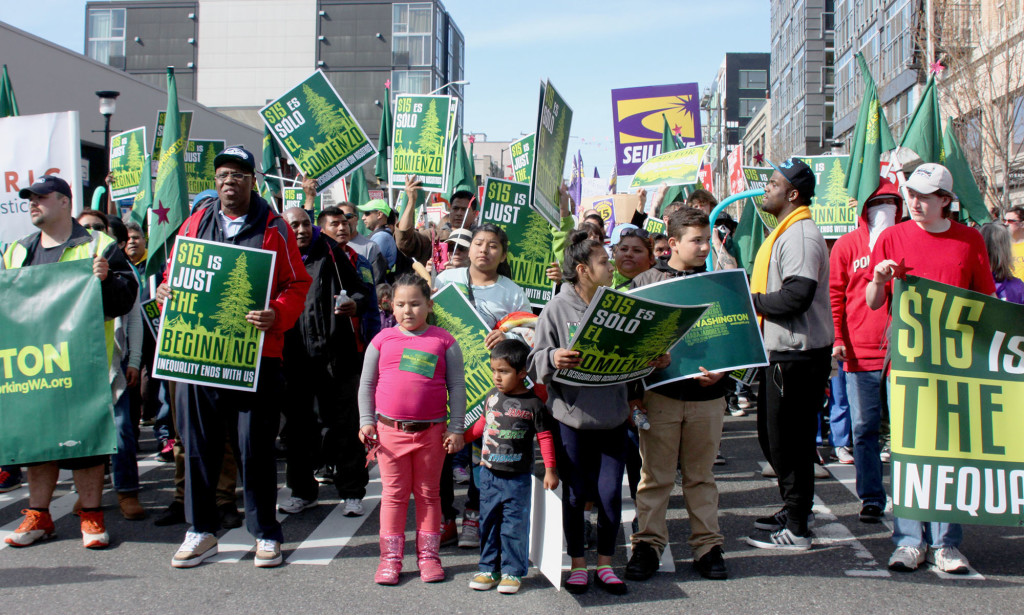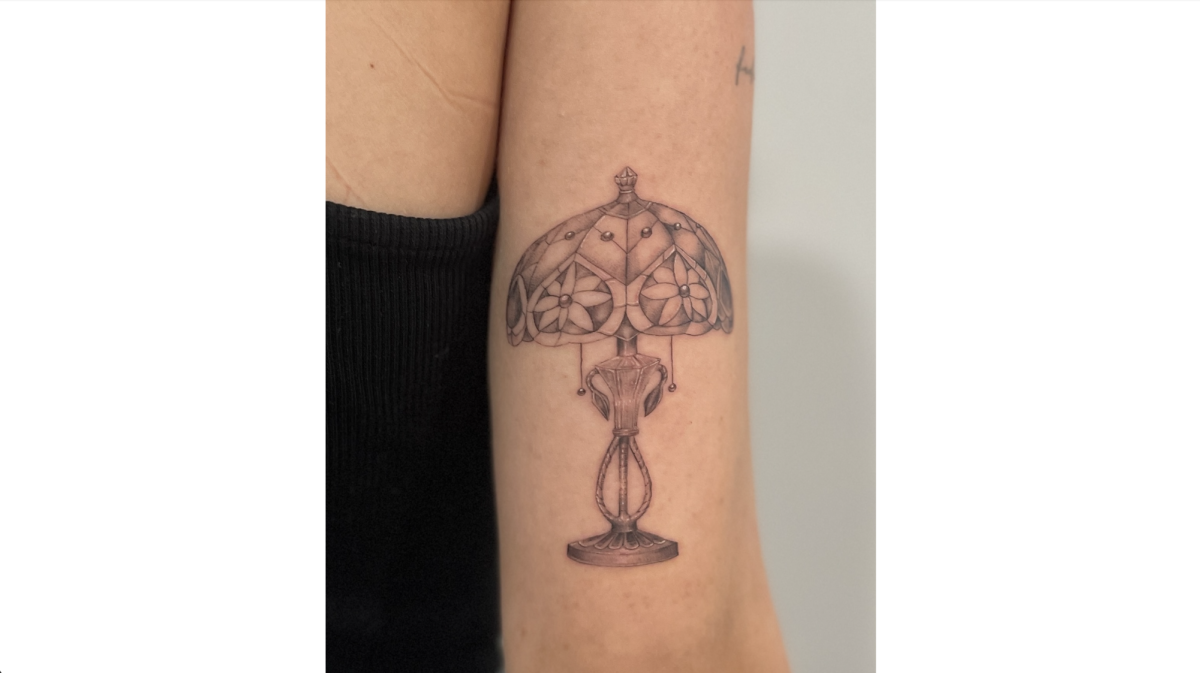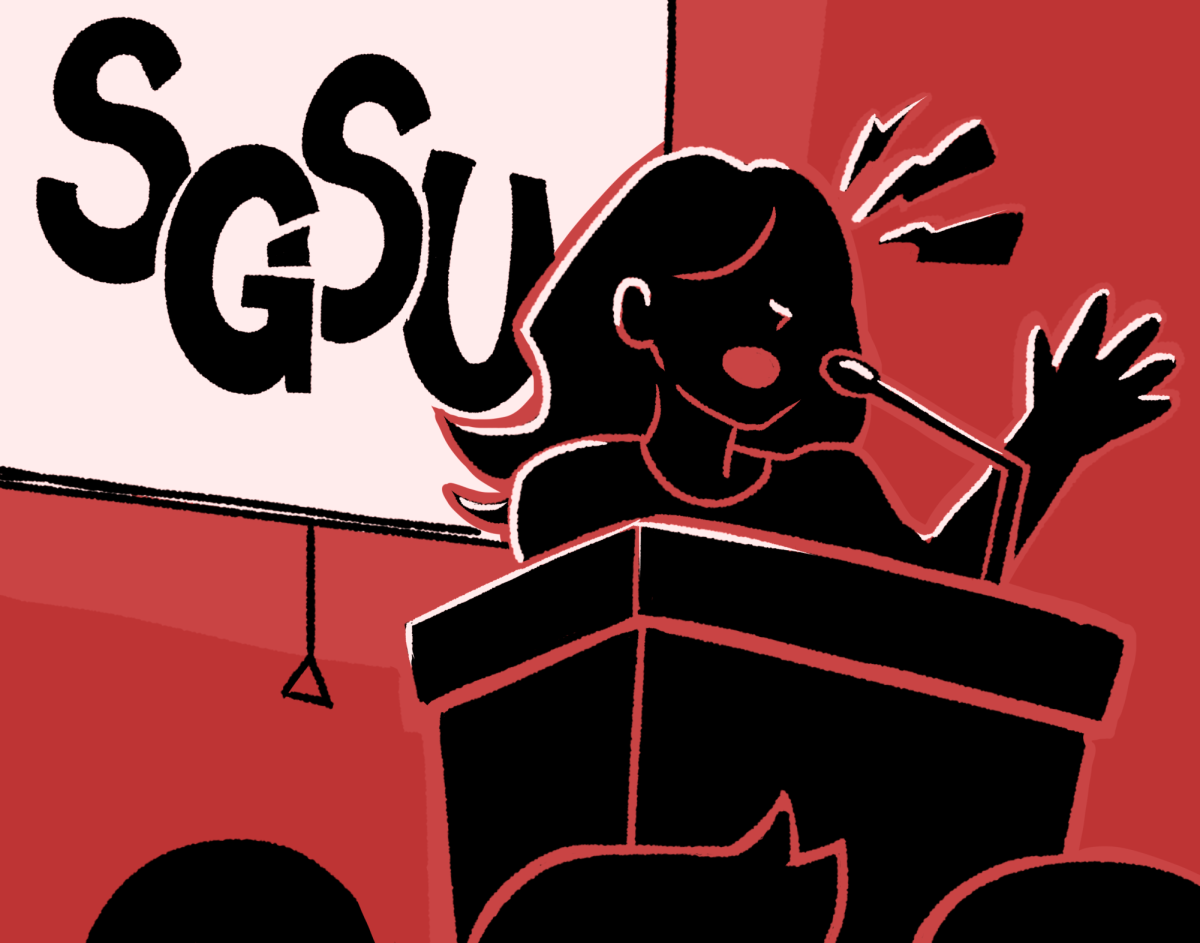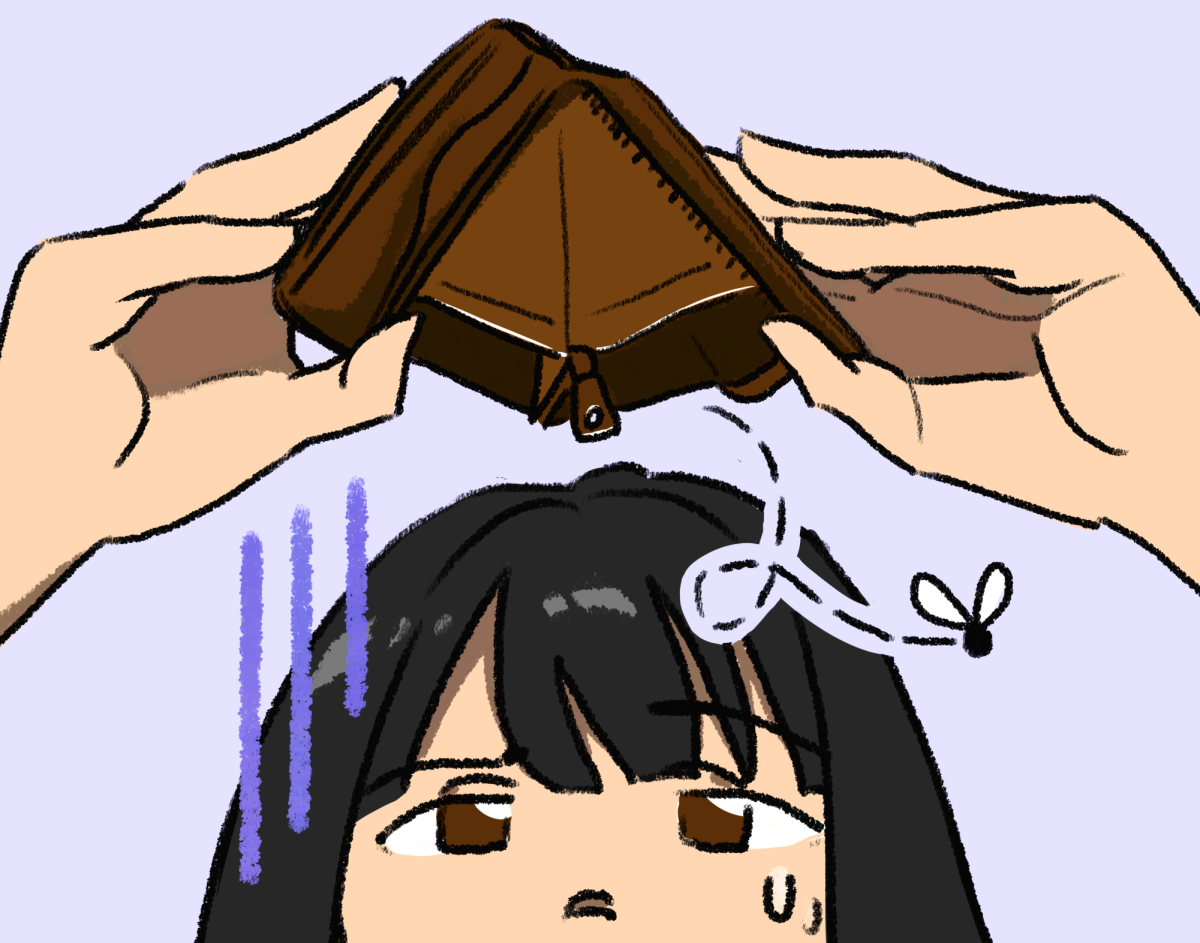On Wednesday, April 15 hundreds of protesters filled the Pigott atrium: hanging banners, waving signs, and showing support for workers in what was one of many demonstrations taking place across the country in a movement for labor rights. One of the organizations, Service Employees International Union, who has led the adjunct faculty unionization efforts at Seattle University, helmed the heavily-attended protest known as Occupy SU. But because the group did not follow university protocol regarding demonstrations on campus, some members of the Seattle U community have raised concerns about the groups trespassing on private property and disrupting classes.
On the day of the massive protest, Dean of Albers School of Business and Economics Joseph Phillips was in his office when he heard the rumbles below. He headed back and forth from his office and a meeting to a spot where he could see the demonstrators pouring into the Pigott Atrium.
Prior to the demonstration, he warned professors who had class during that time of the coming protest so that they could determine how they wanted to respond to the
then-impending situation.
“The only concern I have is obviously doing it at a time that’s disrupting classes, which is very inconsiderate,” Phillips said.
Rewind to almost two weeks before the protest. The university learned through websites and a Facebook page that the group chose to occupy Seattle U as the culmination of a march that made its way throughout the city.
“No one had contacted us about that,” said Seattle U’s Executive Vice President Timothy Leary. “This was sent out nationally, and some of the websites spoke to bringing large numbers of people—and numbers on the website spoke to 900 plus people.”
For Leary and other representatives of the administration, the central concerns are safety of students, faculty and staff, the buildings, and normal operations for the day (such as classes).
Like Leary, Timothy Marron, the executive director of public safety and transportation, was also concerned. And with a crowd size of that magnitude expected to come to campus and the makeup of the crowd at that point unknown, it was enough to cause worry.
Both Marron and the university’s administration repeatedly reached out in an effort to work with the group so that they could demonstrate on campus according to university regulations, but they received no response.
“If you’re going to conduct a protest, you have to follow our protocol,” Leary said.
This applies to any event that occurs on campus, whether it’s a Seattle U–sponsored event or an outside group. The rationale for the protocol is to design a process that can handle the group, which includes discussing safety and liability concerns with potential demonstrators and creating a plan that does not disrupt daily
university operations.
After receiving no response, the administration sent out a letter telling the group that they did not have permission to be on Seattle U’s campus. Still, the group, which included people of all ages and workers from all over the state of Washington, showed up as they had planned.
“We had extra officers on duty,” Marron said.
Public Safety had decided to lock the buildings, but despite those efforts, Marron said that the protesters were able to get inside by having someone from inside the building open the doors.
Senior Erik Hagberg was in his senior synthesis class when the protesters entered the building. His professor decided to take that opportunity to call a normal break typical of a two-hour class, not knowing how long the protest would last. Hagberg and other students went outside to observe what was happening. But there were moments that the demonstration quieted down, and Hagberg said he didn’t think it was too disruptive. His class resumed after the break.
“It’s cool to see members of our campus kind of taking leadership together to send a message about something they’re passionate about that’s relevant to the university,” Hagberg said. “It was cool to see a group of students working with the public, and it seemed to take a lot of initiative and leadership to pull something like that together.”
Although Phillips was concerned that the protest disrupted the academic process, he wasn’t surprised that the Pigott Atrium was used.
“[The Pigott Atrium] is a great venue for a lot of drama, right? You can pack people in, you can hang banners from the balcony, the acoustics, you make a lot of noise and people get fired up about that,” Phillips said.
But Marron said that the atrium was not designed to hold that many people all at once.
“When I looked in there the entire atrium was packed,” Marron said. “There were participants who were coming outside because they were like, ‘It’s way too hot in there.’ The balconies were packed with participants who went up the stairs and were holding banners and whatnot. If a fire marshal had walked in there, that fire marshal would have cited the university for overcrowding in an unsafe way.”
Among the crowd on the balconies was Bon Appetit’s General Manager Jay Payne. He stood overlooking the workers down below at The Bottom Line, the food service located in the atrium.
“I’m up above and right next to me is a man in a bandana pounding his stick on the railing. You never know with that kind of crowd situation what’s going to happen,” Payne said.
Payne had rushed over as soon as he could when he heard word about the protest. He decided to close down The Bottom Line. His main concern was about whether the workers felt safe.
“For me it was the not knowing. How are they feeling? Do they feel safe? Are they ok? Talking to them afterwards, they thought it was weird and strange. But nobody was scared,” Payne said.
According to Payne, six workers’ shifts were either cancelled or they were sent home early. Payne said that sales were 87 percent lower than normal for the afternoon shift.
“[The workers] were a little frustrated that here is a protest that’s ostensibly about workers’ rights and wages and now are denied wages because we had to close,” Payne said. “It’s a union facility for food service. They’re already way ahead of the Seattle minimum wage in terms of how they’re being paid and they have union benefits … I’d like to get that point across that we’re already aligned with that idea.”
Meanwhile, the protesters continued on. Among the many union and community leaders present was prominent city councilmember Kshama Sawant, Seattle’s $15 minimum wage pioneer.
“One of the powerful aspects of the Fight for $15 is that it’s now broadening to encompass the most fundamental agenda of workers rights and workplace rights,” Sawant said in an interview with the Spectator. “It’s important for people to know the adjunct teachers are not isolated. They have the entire labor movement behind them … And there’s a strong push to allow them to unionize and fight for their workplace rights collectively.”
Sawant, who once taught economics as an adjunct in the same building she was protesting in now, didn’t see the classroom disruptions as a hindrance to students’ learning.
“As a teacher myself, I place a great value on classroom education and I strongly believe in empowering students in their intellectual and academic achievements,” she said. “It’s also extremely important to ensure that young people at the same time are empowered to become leaders in social movements.”
Manuel Carrillo, a former Seattle U student and Bon Appétit employee, agreed.
“This is very much aligned with the commitment to teaching and to learning,” Carrillo said. “These types of events or gatherings, whether planned or unplanned, also contribute a lot to the learning experience and to our abilities to engage with one another and to engage with the issues facing Seattle University, facing the city of Seattle, and [facing] our world.”
Senior Olivia Engle, a member of Reignite the Mission and participant in the April protest, is frustrated with the injustices facing adjunct faculty, which is why she chose to participate.
“We’re trying to raise awareness of the fact that while we consider professors to be a really high esteemed position—a very respectable career—it’s really not the reality that so many of them face today around the country,” Engle said. “I know of adjunct faculty whose apartments are smaller than President Sundborg’s office, and I find that extremely disheartening.”
Adjunct professor Benedict Stork, who teaches film studies and is part of the organizing committee on campus which works in collaboration with SEIU, explained that the group’s decision to bypass university protocol was connected to the administration’s continued refusal to allow adjunct faculty to unionize.
“In part, this was about asserting our desire to have those votes counted,” Stork said, referring to the votes cast by adjunct faculty to form a union.
Stork added that the administration’s perception that the protest earlier this month was facilitated in large part by an outside group is a flawed one.
“We are the part-time contingent faculty who do the majority of teaching on campus,” he said. “To treat us as an outside group reflects the university’s response which has been to stall and reject our desire to have a union by the withholding of [the] votes.”
The group eventually left to march on 12th and Madison, where 21 people sat in a circle blocking traffic, ready to be arrested for civil disobedience. Carrillo was one of the arrested protesters.
“I’ve been involved in rallies and protests but have never done something like this,” Carrillo said. “Up until the moment we sat down, I was afraid, but the moment that we got in a circle and we made a commitment to each other—a non-violent pledge—the fear went away because I knew that I was surrounded by an amazing group of people and we were going to take a stand, but we weren’t going to get out of hand.”
For Carrillo, the stand he was making was this:
“When I was actively taking classes, I feel like it was oftentimes those adjunct professors, those contingent professors, who were the ones who cared the most for me,” Carrillo said. “A lot of the professors who spoke [at the demonstration] are professors who I still see on a regular basis … The passion they have for education continues to push me to be involved in issues of justice because they’re struggling, and yet they love their job.”
Associate Provost of Academic Achievement and long time member of the Seattle U community Charles Lawrence said that his central concern from his administrative standpoint is for the safety of students during these protests. But he needed to balance his genuine concern as an administrator with a similarly important perspective—one informed by his background as a sociology professor. He recognized that at a university with a definitive social justice mission, there are going to be times when there will be tension between university protocol and democratic action like protest.
“There will always be competing values,” Lawrence said. “Debate, protest, democracy can sometimes be messy, and I think it’s important for us to tolerate some minor disruptions in daily routine.”
He did, however, stress the importance of civil dialogue and acknowledged that our campus culture is one where respectful conversation is the rule.
“… And that’s as it should be at a university,” he said.
But protests and demonstrations, like study abroad and volunteering, are ways in which Seattle U students engage with social justice issues, Lawrence said. And these occasions of activism provide important skills and values that can be useful to students looking to organize and influence policy. Advocacy, he said, is important if students are going to effect change in the world.
He added that the demonstration is an opportunity for the university to engage in dialogue both with protesters and the campus community. Seattle U, he said, is a place where people can talk about what they stand for and why they stand there.
“That’s part of the lifeblood of the university.”












